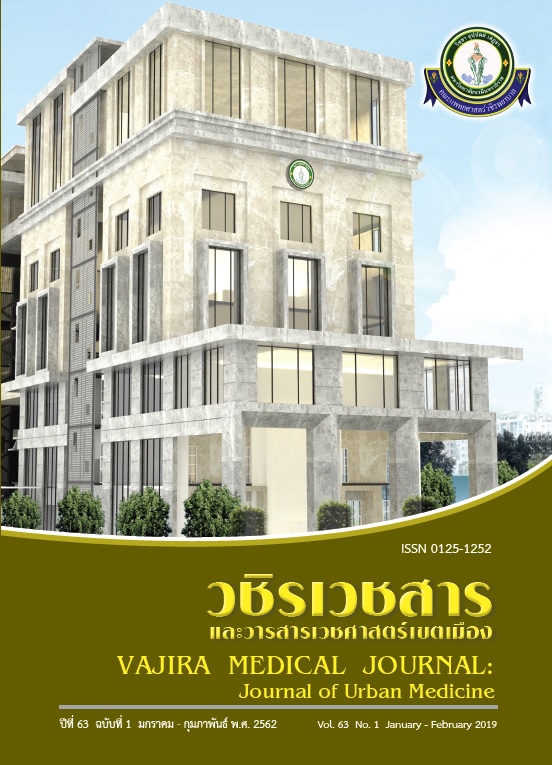Satisfaction and Needs of Medical Students for Pre-clinical Teaching at Faculty of Medicine, Vajira Hospital, Navamindradhiraj University
Main Article Content
Abstract
Background: The teaching systems for pre-clinical students are lecture base learning (LBL), which is combination with problem base learning (PBL), so that medical students can gain basic medical science knowledge in order to continue study in clinical level. For improve the medical education system is necessary to collect the relationship between education system and learning outcome, and requirement of pre-clinical teaching method.
Summary of work: The survey are conducted in the third year of pre-clinical students of faculty of Medicine, Vajira Hospital, who had experienced in variety teaching methods. The questionnaire were used to study satisfaction rating and requirement of education management.
Summary of result: 72 medical students (48.61% male, 51.39% female), which are high level of satisfied rate in LBL (72%) and moderate level in PBL. As the result of the relationship between medical education system and learning outcomes are coherence, which are statistical significance (r= 0.265, p= 0.025). The interaction between grade point average (GPA) and requirement of education management shown the same result in every group of GPA as LBL, PBL and self-study, respectively.
Conclusion: The satisfaction and requirement of this research shown LBL was the most learning method in overall medical student, Vajira hospital.
Take-home messages: The LBL, PBL and other active learning are the most powerful teaching method for medical school. Medical students adopt themselves in every teaching method to improve clinical knowledge for medical professionalism.
Downloads
Article Details
References
2. M.H. Davis and R.M. Harden. AMEE Medical Education Guide No. 15: Problem-based learning: a practical guide. Medical Teacher. 1999
3. Bonwell. Active Learning: Creating Excitement in the Classroom. Clearinghouse on Higher Education. George Washington University, Washington DC; 1991
4. Meyers C. and Jones T. Promoting active learning:strategies for the college classroom.
5. สำนักแผนและประกันคุณภาพการศึกษา. แนวทางการดำเนินงานด้านการเรียนการสอนในศตวรรษที่ 21
6. Krejcie, R.V. and Morgan D.W. Determining Sample Size for Research Activities. Psycholological measurement. 1970: 607-10
7. ธีรวุฒิ เอกะกุล. ระเบียบวิธีวิจัยทางพฤติกรรมศาสตร์และสังคมศาสตร์. อุบลราชธานี: สถาบันราชภัฎอุบลราชธานี.
8. สมชาย วรกิจเกษมสกุล. ระเบียบวิธีการวิจัยทางพฤติกรรมศาสตร์และสังคมศาสตร์. มหาวิทยาลัยราชภัฏอุดรธานี
9. บุญชม ศรีสะอาด. การวิจัยเบื้องต้น, พิมพ์ครั้งที่ 7. กรุงเทพฯ: สุวีริยาสาส์น, 2545
10. เจนต์ปิยะ อ้นมี, ยิ่งยศ จุลกิจวัฒน์ และ ศราวุธ นุกูลอุดมพานิชย์. ทัศนคติของนิสิตแพทย์ มหาวิทยาลัยนเรศวรต่อการเรียนการสอนในระดับชั้น Pre – clinic และ Clinic.
11. นชุจรีย์ หงษ์เหลี่ยม, พัชดาพรรณ อุดมเพ็ชร, พรรณิการ์ พุ่มจันทร์. การศึกษาทัศนคติของนักศึกษาแพทย์ ชั้นปรีคลินิกต่อการจัดการเรียนการสอน หลักสูตรแพทยศาสตรบัณฑิต ของคณะแพทยศาสตร์ศิริราชพยาบาล, เวชบันทึกศิริราช. 2558;8: 10-8.
12. ธัญจิรา จิรนันทกาญจน์. การใช้แบบเรียนออนไลน์ในการศึกษาแพทยศาสตร์, เวชบันทึกศิริราช. 2559;9:98-106.
13. ไชยยศ เรืองสุวรรณ. เทคโนโลยีการสอน. การออกแบบและพัฒนา. กรุงเทพ ฯ: โอเดียนสโตร์ 2533.


